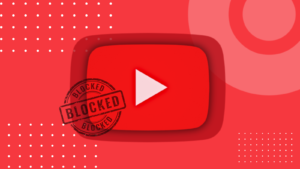YouTube Adds Channel-Level Ad Category Blocking Controls

Introduction
YouTube is making a significant move to give content creators more control over the types of ads displayed on their videos by introducing channel-level ad category blocking controls. This feature, which was previously available only through AdSense, has now been integrated into YouTube Studio. It aims to empower creators by allowing them to block specific categories of ads that may not align with their content or audience preferences.
What is Channel-Level Ad Blocking?
Channel-level ad blocking allows YouTube creators to prevent certain types of ads from appearing on their content. This feature was previously managed via AdSense, but now YouTube has brought this functionality directly into its platform, making it more accessible to creators who have watch page monetization enabled.
Creators can now access these ad category blocking controls easily via YouTube Studio on their desktop. Here is a quick breakdown of how the feature operates:
-
Where to Find It:
Creators can navigate to the Settings tab within YouTube Studio to manage their ad preferences.
-
Who Can Use It:
The feature is only available to creators whose channels are eligible for watch page monetization.
-
What It Does:
By enabling creators to block specific ad categories, this tool gives them the power to ensure that only ads that align with their content and audience are displayed on their videos.
For creators, this move represents a new layer of control over the advertising that takes place on their channel, allowing for better alignment between content and the brands that appear alongside it.
Why This Matters for Creators and Advertisers
-
Brand Safety and Creator Autonomy
Brand safety is a vital issue for both creators and advertisers. Creators want to make sure that the ads running on their content are consistent with their values and do not alienate their audience. Similarly, brands want to ensure their ads are displayed in a safe environment that does not damage their reputation.
By offering channel-level ad blocking, YouTube empowers creators to exclude ads from certain categories that may not be suitable for their viewers. For example, a family-friendly content creator may choose to block ads for alcohol, gambling, or other sensitive categories.
This tool also removes the need to navigate through the more complicated AdSense interface, streamlining the ad management process for YouTube creators.
-
Potential Impact on Revenue
While greater control over ad categories is beneficial for brand safety, it may come with trade-offs. YouTube warns that blocking specific ad categories could reduce channel revenue. When creators block ads from certain categories, they reduce the pool of available advertisers, which may lead to fewer ads being served and ultimately lower earnings.
It is also worth noting that Google may experience a hit in revenue, as more channels choose to limit the types of ads that appear on their content. However, for creators, the choice comes down to balancing ad revenue and maintaining a high standard for brand safety and audience satisfaction.
-
Increased Competition for Ad Placements
For advertisers, the introduction of channel-level ad blocking controls could lead to increased competition for fewer placements. As more creators block specific ad categories, the number of available ad spaces may shrink, forcing advertisers to compete for placements that are still available. This could drive up ad costs in certain niches, affecting campaign performance and reach.
However, for brands that value ad placement control, this shift can be seen as a positive. Advertisers will have more confidence that their ads are appearing in brand-safe environments where creators have curated the types of ads shown on their channel.
Is It Worth the Risk?
There’s always a catch when it comes to giving users more control over monetization. YouTube cautions creators that blocking certain ad categories may lead to a reduction in channel revenue. With fewer ads eligible to appear on their content, creators may see fewer impressions and lower earnings.
For creators who rely heavily on ad revenue to support their channel, this could be a difficult decision. While the ability to block ads that do not align with their content is a welcome change, it may not be in every creator’s best financial interest.
As with any tool, it is important to use these ad blocking controls wisely. Creators must carefully consider how blocking certain ad categories will impact their income and whether it is worth the potential reduction in earnings to maintain a stronger brand and audience alignment.
A Step Toward Improved Monetization
Despite the potential revenue risks, this move by YouTube could mark a step toward improved creator satisfaction. Direct control over ad blocking allows creators to better manage the ads that appear on their content without the hassle of going through AdSense. This change could improve the overall monetization experience, leading to happier creators and more engaged audiences.
While YouTube has spent years cracking down on ad blockers to avoid legal issues, this move signals a shift toward giving creators more autonomy over their monetization. By simplifying ad management and offering creators a more direct way to control their ads, YouTube is empowering its content creators.
What Is Next for YouTube Creators?
YouTube’s channel-level ad blocking controls are expected to roll out by the end of this week. For creators, this marks a significant change in how they can manage advertising on their channels.
Here is what to keep in mind moving forward:
-
Balance revenue vs. brand safety:
Creators should weigh the potential decrease in revenue against the benefits of maintaining a safe, brand-aligned channel.
-
Stay informed:
Regularly review the ad categories you have blocked to ensure they still align with your channel’s goals and audience.
-
Monitor ad performance:
Keep an eye on how blocking certain categories impacts your channel’s ad revenue and adjust your settings as needed.
Conclusion
YouTube’s introduction of channel-level ad category blocking controls gives a video creator more autonomy over the types of ads displayed on their content. While this move can enhance brand safety and offer greater control over monetization, it comes with the potential drawback of reduced revenue. Creators will need to find the right balance between ad revenue and ensuring their content aligns with their brand and audience values.
Ultimately, this change empowers creators to make informed decisions about the ads that appear on their content, shaping a more customised advertising experience for both creators and viewers alike.
(Source)
Before blocking ad categories, creators should weigh the potential decrease in revenue against the benefits of aligning ads with their audience’s preferences. It is important to find a balance between brand safety and monetization.
Advertisers may face increased competition for fewer placements as more creators choose to block specific ad categories. This could lead to higher costs in certain niches or a shift in how ads align with content.
Yes, creators can always adjust their ad blocking settings. If you find that blocking certain categories impacts your revenue too much, you can unblock them via YouTube Studio at any time.





